The Proper Seated Bent-Over Rear Deltoid Raise and Its Variations
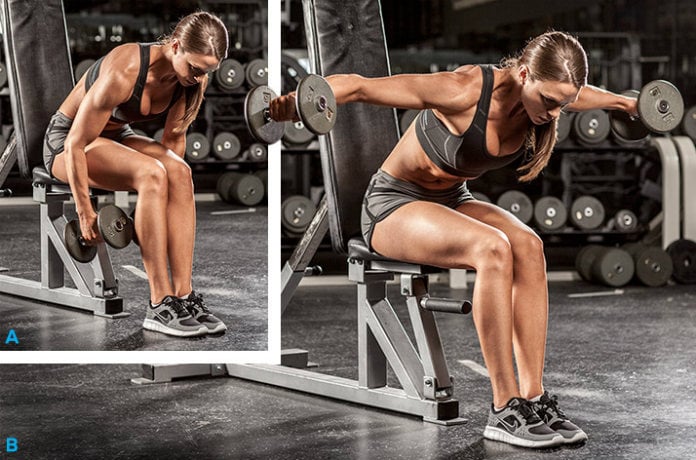
Seated Bent-Over Rear Delt Raise is a type of workout that targets your posterior deltoid. Deltoid encompasses the muscles on top of your shoulder or on the uppermost part of your arm. Their shapes are rounded and triangular whose two sides are called anterior and posterior.
In this kind of workout, it purposely addresses on how to make the posterior deltoids toned and have more mass. A lot of people can do or withstand this because of its medium difficulty type of exercise.
It focuses on building strength and size of the posterior delt. Before, this started as an exercise for bodybuilders in enhancing their backside poses on the stage. Nowadays, its uses have gone more benefits other than aesthetics.
This muscle on the backside of the shoulder will improve not just the strength but also the shoulder health and posture. This post discusses everything you want to know about this workout.
Why You Should Do Seated Bent-Over Rear Delt Raise
Shoulder workouts mainly help define muscles, better strength and improve balance and stability. It may be your primary shoulder workout, among all others. Here are reasons why you should consider doing this workout.
-
- The posterior or rear deltoids develops and strengthens leading to a more robust upper back
-
- It keeps the rotator cuffs from happening. Rotator cuffs frequently causes shoulder injury.
- Those who do this workout improves more power within other workout variants. For example, squats and bench presses will become easier. It will help keep the body in a balanced position and form with the rest of the body.
What Are The Muscles Involved?
Obviously, the workout addresses shoulder or deltoid muscles while focusing on the middle and posterior deltoids. To be more specific, here are the types of muscles being targeted and worked out:
-
- Antagonistic Muscles: pectoralis major, front (anterior) deltoid and biceps
-
- Primary Targeted Muscle: rear (posterior) deltoid and the trapezius )upper back along with the neck
- Secondary Targeted Muscle: infraspinatus and the triceps, lower back muscles along the vertebral column, teres major and minor, latissimus dorsi, middle deltoid and rhomboids
Do Rear Delt Raise And Bent-Over Lateral Raise Differ?
No, they don’t have any difference. Bent-over lateral raise and rear delt raise are used interchangeably by different educational resources and coaches. However, this exercise can be mistaken with lateral raise. In fact, they differ with the standard lateral raise. Lateral raise targets the lateral portion of the deltoid muscles which can be done standing upright.
After knowing some essential knowledge of the exercise, it is best to know common mistakes when executing so that you may want to prevent to the same. Before jumping on the proper way of doing the exercise, avoid the following as well as follow the do’s and don’ts:
Do’s And Don’ts
Don’t…
-
- Let the your weights or dumbbell hit one another during the workout
-
- Let lift your torso at the same time as you lift your weights. Rather, let the body move still
- Let your body swing any moment. Rather, let only your rear delts raise the weight
Do…
-
- Feel your elbows guide the lifting rather than your hands
-
- Bent your elbows at about 10 degrees angle to avoid straining
-
- Touch your chest or come as close as possible to your thighs
-
- Close your thighs. Let them be close together
- Held the dumbbells with your hands facing downward. This improves rear deltoid isolation
Step By Step Guide For Seated Bent-Over Rear Delt Raise
Starting Position
-
- Begin by sitting at the edge of a flat bench. Let your feet close together because this will gain more strength. Place the dumbbells with different weights on the floor in front of the bench. Using the lightest weight and your feet close together will create an effective balancing and overall workout.
-
- Once sited, bend forward till your shoulders are above your knees while your chest is over your knees. Bend as much until you can feel your body touch your whole thighs.
- Take the pair of dumbbells on each hand. Hold and place them at the back of your calves. The dumbbells must look forward.
Movement
-
- Assuming after the starting position, lift the weights straight from your sides. Raise them until your arms become parallel with the floor.
-
- Make sure that your two arms also look parallel with each other. Like already said, avoid swinging your torso.
-
- Once the arms become parallel with the floor, make sure your elbows bend a little bit. Hold then squeeze your shoulder blades. Pause for two counts.
-
- After two counts, slowly lower the weights back to the starting position
- Strive for 10-12 reps. However, different amount of repetitions differ to the different levels and different workouts. You may also do this for four consecutive days a week.
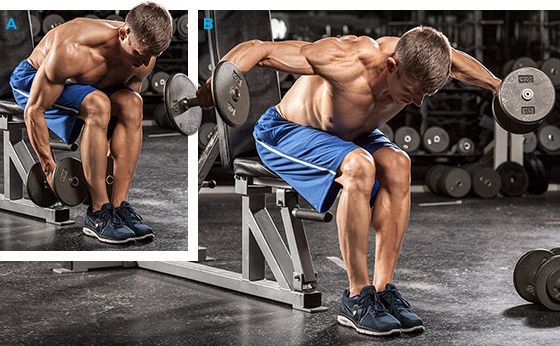
Benefits Of Doing This Exercise
Efficient Warm Up/ Isolated Exercise
Rear delt raises makes a very beneficial warm-up or post workout exercises. This upper body exercise comprises the chest, shoulder, arm and back. It focuses on the small groups of muscles. You can rather have more repetitions that increasing more weight.
Strengthens Shoulder and Elbow Joints
Commonly known as rear shoulder raise, it concentrates on the back deltoid muscles. An isolation workout that requires strenuous body movements making more robust shoulder and elbow joints
Extension of Joints
Rear deltoid raise trains the rear deltoid muscle. The training uses glenohumeral joints that are extended and elongated with regular intensity-full sets. Hyper extension form is a variation of this exercise.
Robust Upper Back
One very important part of the body is the back. This kind of exercise can help develop, balance and strengthen the rear deltoid muscles of the shoulders. Not only will it make your back muscles and shoulders robust but also less prone to injuries.
Helps in Heavy Duty Workout
Your heavy duty workouts like squats and bench press will be easier, if you do rear delt exercises. They boost capacity of the body to lift more weight in executing heavy duty workouts. Heavy duty workouts impact the biggest muscles in your body thereby making them stronger.
In a nutshell, your muscles become stronger and denser when you do more intensive workouts.
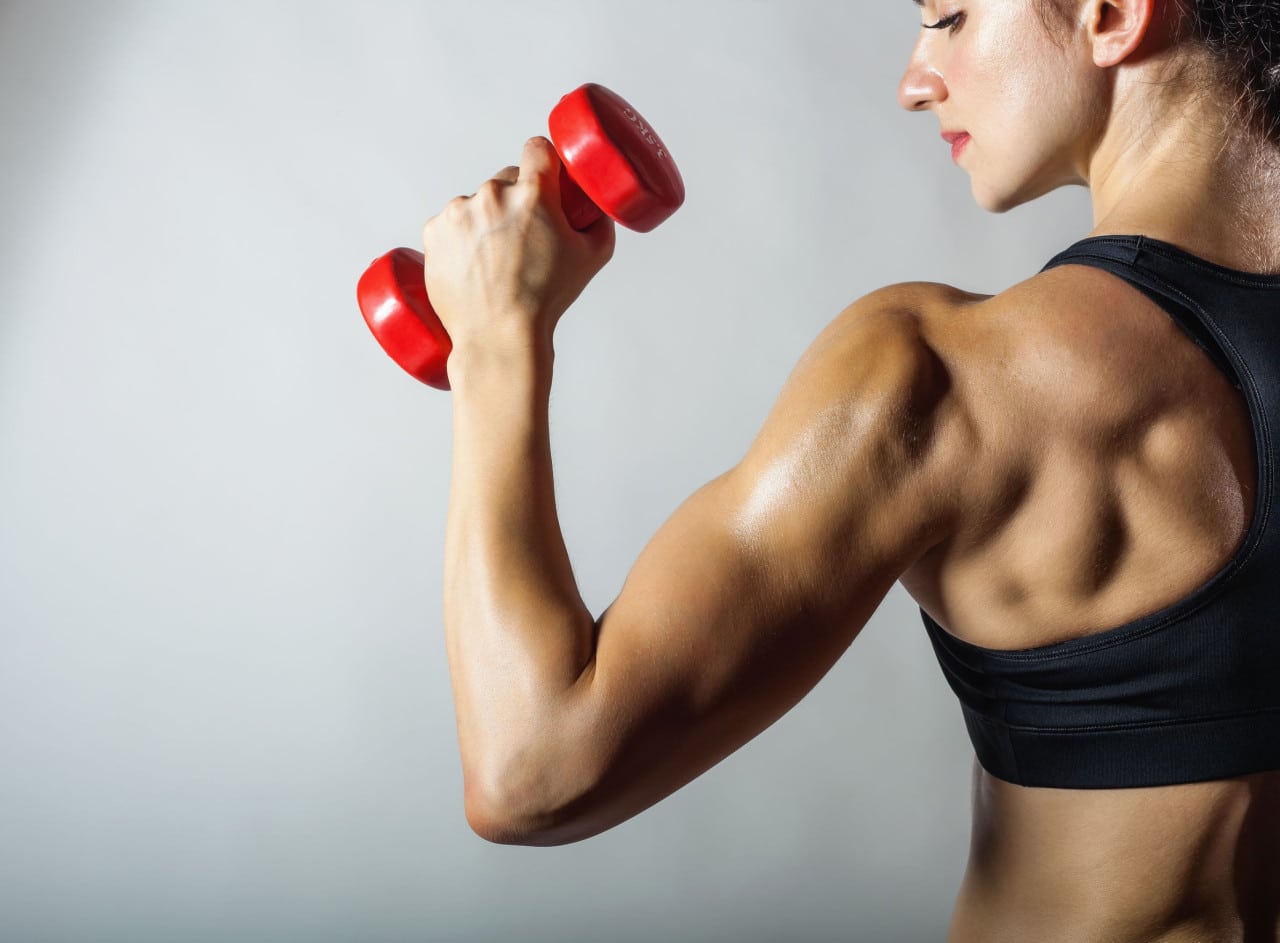
Bent-Over Lateral Raise Mistakes
Bouncing
People might make a mistake of using the wrong weight or dumbbell causing rocking and swinging. This makes a momentum exercise and won’t challenge the rear delt effectively. It also takes away the dumbbell’s ideal path or angle. This no longer works a upper back and rear delts. So, you better use a lighter weight.
Rocking
This holds common mistake for most people starting out this exercise. If your arms slant at an angle with your torso, this becomes a back exercise working on the lateral and other back muscles. Instead, move your arms perpendicular to your torso.
Using Heavy Weights with Low Reps
Using heavy weights may become a strength exercise like shoulder press. This may only lead to bouncing and targeting other muscles like the large back muscle. So do a specific range of reps like 15-25 using light weight for more control and more effective strength on the rear delt.
Upright Posture (For Standing Rear Delt Raise)
Standing too far upright shifts the line of the pull onto the anterior head of the shoulder which is the front portion. It also reduces the activation of the side delts. Standing with your upper body completely rigid and upright throughout the exercise doesn’t work on your rear delts. Instead, keep a small bend in your knees and lean slightly forward.
Replacement Exercises Using Dumbbells
Incline Rear Deltoid Raise
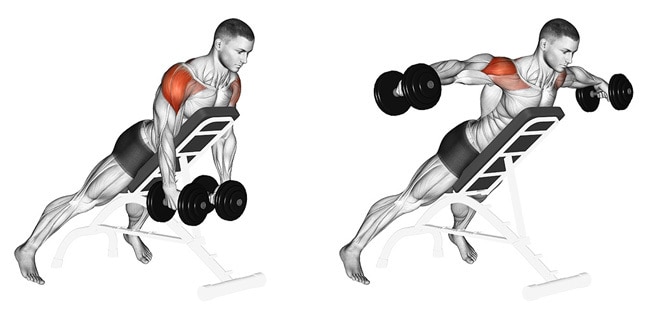
The incline position of this activity disconnects the deltoid muscles which makes the movement more thorough. Since it’s done on a bench, the lower back is upheld, decreasing the danger of injury. In this activity, your back deltoid becomes in-charge of stretching out your shoulder to the back and rotating your shoulder outward.
The incline deltoid raise likewise works your mid trapezius and rhomboid muscles situated between your shoulder bones and are additionally critical for posture and shoulder health. The position will dispense with any chance to cheat by shaking your body and any awkward (and even risky) strain on the lower back.
How to do it
Starting Position
-
- Sit facing an incline bench ( angled to around 15-30 degrees), with your stomach and chest leaning toward the incline.
-
- Grasp a dumbbell in each hand and let your arms hang freely down with your palms situated toward each other (neutral hold).
- Your legs should be shoulder-width apart, your feet on the floor, and your chin simply above the top of your bench.
Movement:
-
- Keeping your elbows loose, raise the dumbbells from your sides and upward in a wide curve until the point that they are somewhat higher that the shoulders.
- Compress your shoulder bones together for one entire second before gradually bringing down the dumbbells to the beginning position.
Head-Supported Dumbbell Lateral Raise
The same as the basic bent-over dumbbell lateral raise only that it uses support on your forehead. It utilizes the uppermost end of an incline exercise bench. The bench as a support to your head impedes spine movement. It also prevents the dumbbells to swing upward with momentum. This works your back shoulders effectively.
How to do it
Starting Position
-
- Remain behind an incline bench and bend forward at your hips to the point that your head touches the top of the backrest (highest end of a incline seat).
-
- The backrest ought to be set at a suitable height– for your torso to be relatively parallel to the floor.
-
- Let your arms to hang straight down from your shoulders.
- The palms of your hands should face each other (unbiased grasp) and your torso, nearly or completely parallel to the floor.
Movement:
-
- With palms facing together, gradually lift the dumbbells up (to ear level; simply over a flat line) and out to the sides of your body, pulling through the back delts and rhomboids.
-
- Make sure to keep your torso forward and motionless amid the movement. The dumbbells should follow a semi-circle in a vertical plane.
-
- Compress your shoulder blades together toward the ending of the movement.
- After a short delay at the best, gradually take the dumbbells back to the starting position.
Dumbbell Lying Rear Deltoid Raise
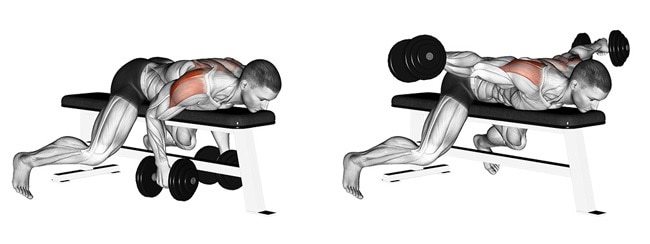
Lying rear laterals do not differ with seated bent-over lateral raises but this time, you lie face down on a bench. Worry no more of your lower back or your balance. This effectively reduces tension on the lower back (lumbar) region and minimizes the risk of swinging your upper torso.
You must definitely try this because of its effectiveness.This awesome exercise works the rear deltoid head, the part of the shoulder where many individuals have a tendency to disregard when they practice their shoulders.
How to do it
Starting Position:
-
- Lie face down on a in flat bench with your legs, chest and stomach on flat bench and your head at the top. Your jaw should be over the top of the bench.
-
- Hold a dumbbell in each hand with your palms situated toward each other.
- Let your arms a chance to hang down freely with the elbows somewhat bent.
Movement:
-
- Bring your arms up in a wide, arcing movement out to the sides until the point that your elbows level your shoulder while your arms becomes parallel to the floor.
- Compress for one count before gradually coming back to the starting position and repeat for the desired repetitions.
Seated Bent-Arm Bent-Over Dumbbell Row
Perfect method should keep up while doing this back deltoid exercise for its effectiveness. Improper execution may prompt damage or lack of accomplishment of your working out objective. Thus, that one who plays out this activity must do the right form to accomplish the best from this valuable exercise.
How to do it
Starting Position:
-
- Place a pair of dumbbells parallel to and before a flat bench.
-
- Sit on the edge of the seat with your legs together and the dumbbells behind your calves.
-
- Bend at the waist while holding your back straight so that you can get the dumbbells. As you lift them up, the palms of your hands should face each other. You can likewise utilize overhand grasp – thumbs facing each other.
- Bend at the elbows until a 90-degree angle forms between the forearm and upper arm.
Movement:
-
- Keep your torso forward and stationary with arms bent at a 90-degree edge at the elbows, and lift the dumbbells straight to the side until both upper arms are parallel to the floor. The lower arms should be indicated to the floor in this contracted position. Breathe out as you lift the weights. Refrain from swinging the torso or bringing the arms back instead off to the side.
-
- Following a one second contraction at the top, gradually bring down the dumbbells back to the starting position.
- Repeat for the recommended repetitions
Bent-over Dumbbell Lateral Raise (Standing)
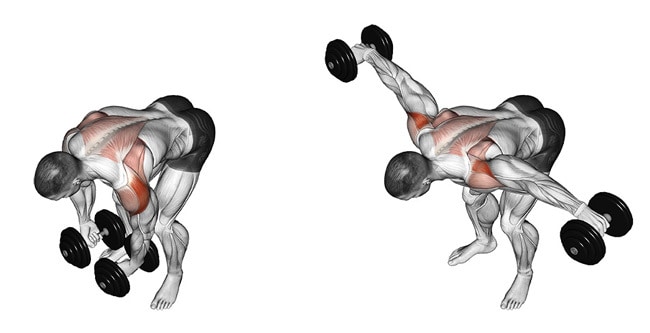
It develops your shoulders and rhomboids which are your posterior deltoid muscles and the middle section of your back. Bent-over dumbbell lateral raise can be done either sitting or standing. However, always make sure your body us in good position to avoid engaging bigger muscles of your back.
How to do it
Starting position:
-
- Begin by standing then slightly bending your knees
-
- Hold a pair of dumbbells with palms facing downward
-
- Bend forward from the hips while keeping your back up and head up.
- Let your arms hang straight down from your shoulder then bend your elbows slightly
Movement:
-
- From the position of your palms facing downward, lift up your dumbbells and out to the sides of your body. This pulls through the rhomboids and the rear delts.
-
- Once your arms reach at ear level, slowly lower down your arms to the start
- Do not use momentum but try to imagine the space between your shoulder blades gets smaller as you raise the dumbbells
Conclusion
The Seated Bent-Over Rear Delt Raise is classified under the isolation exercise class. the fact that this workout focuses only on the shoulder muscles and joint so that target becomes isolated and the only thing mobilized. The steps are almost the same way with doing the standing bent-over lateral raise.
Only that, you improve better balance while sitting but you may get strains on your lower back while standing. This is a very good exercise for toning up your shoulder muscles with greater muscle mass.
